NBA Season Preview 2021-2022: Eastern Conference
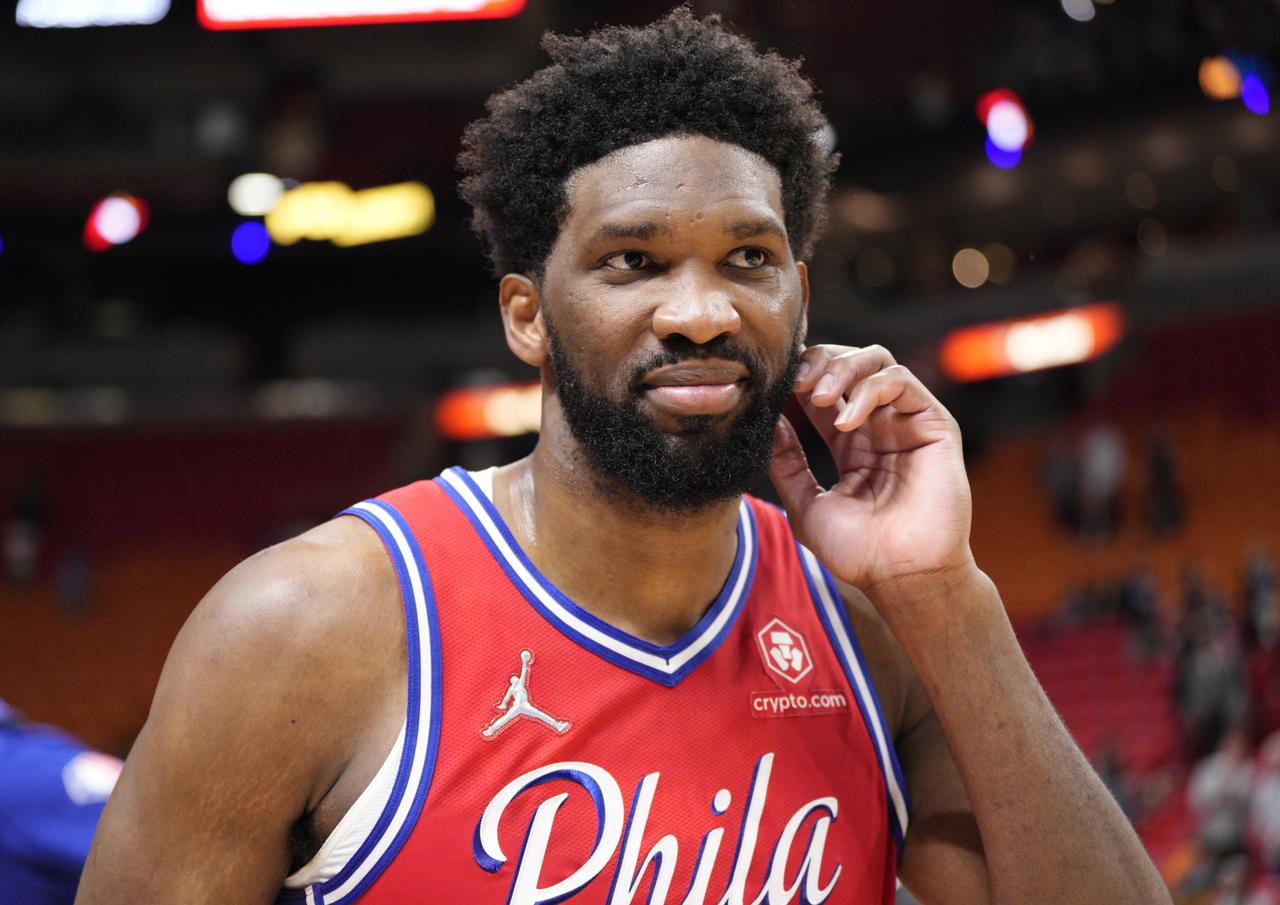
Atlanta Hawks
Added: Dejounte Murray, Justin Holiday, Aaron Holiday, Frank Kaminsky, Vit Krejci, Jarrett Culver (Two-Way), Trent Forrest (Two-Way), AJ Griffin, Tyrese Martin
Lost: Kevin Huerter, Danilo Gallinari, Delon Wright, Gorgui Dieng, Kevin Knox, Lou Williams, Skylar Mays, Timothe Luwawu-Cabarrot, Sharife Cooper, Chaundee Brown
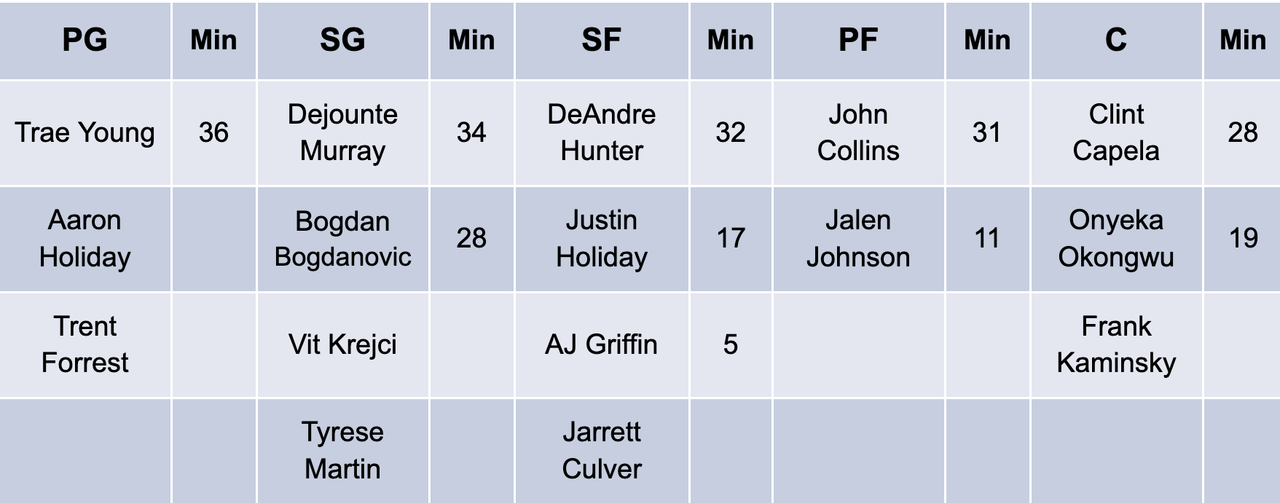
Best Case Scenario:
No one outside of the Hawks’ locker room knows if they started to believe their own hype and that led to complacency last year. They started the season slowly with a 17-25 record, but reeled off seven straight wins and finished 26-14 in their last 40 games. While health and COVID issues influenced a slow start, the Hawks bounced back with urgency and played like a cohesive team. If the core they retained—Young, Bogdanovic, Hunter, Collins, and Capela—can continue to play with that same effort, then they will not underachieve. Adding Dejounte Murray into that mix raises both their floor and ceiling. Carrying their final 40-game win percentage into a full season is a 53-win effort, and adding an All-Star could propel a surprise run to 50 wins with the right breaks.
Worst Case Scenario:
Extrapolating results from the final 40 games of a season is a bad model, and the Hawks are not guaranteed to win at that rate in an improved Eastern Conference. This is still a flawed team, as the Heat series that ended their season proved. Clint Capela fell off from being a high-level pick-and-roll finisher last season, and he was also far from his fringe DPOY effort. The progression of John Collins and DeAndre Hunter has plateaued too, and there are no guarantees that the Hawks get the best of either. Additionally, Murray’s opportunities largely come at the expense of Collins and Bogdan Bogdanovic, and the impact of both players in lesser offensive roles makes them less valuable. The fit of Murray next to Trae Young is also not guaranteed to work, as Murray will be playing off-ball more than he has previously. Overall, the Hawks claim enough talent to win 50 games and a playoff series again, but the pieces may not coalesce enough to succeed.
How does the Dejounte Murray fit play out?
There are a couple of factors that give the Young-Murray offensive backcourt hope. First, they can stagger their minutes to maximize both players. Second, Young’s shooting off the ball has been underutilized in his career. They are now able to run more sets that mirror the way Stephen Curry has been used off-ball. But the crux of the issue is that Murray, a 32.7% three-point shooter, will be cast more in an off-ball role while Young is the primary initiator. It is an issue they will need to be creative to work through, and their spacing could be compromised if it proves to be less of an ideal fit.
Overall, Atlanta will work through this over the course of this season to find the right balance. Defensively, Murray fixes their key issue in the backcourt. Young needs the easy defensive assignments, and Murray can check lead guards in a way that Kevin Huerter and Bogdanovic never could. The pairing always made sense on the defensive end, but the offensive fit will prove trickier. Expect Murray to have more open threes but decreased stats in a lesser role. The peaks of 21.2-8.3-9.2 should come down due to purely volume reasons, and a rough balance of 17.5-6.5-6.0 should be expected in this new role.
How does the addition of Dejounte Murray impact the other Hawks statistically?
While Murray is not due to match his peak usage, rebound, or assist stats, he will certainly exceed Kevin Huerter’s production. We’ll examine three core stats and how adding Murray affects the Hawks' core to better understand his overall impact.
Rebounding is the simplest stat to measure, even if Murray is a top rebounding guard. Expect Capela and Collins to be negatively affected the most, with Capela no longer being a threat to lead the league in boards. Expect every Hawk to grab 1-2 lesser rebounds per night.
As for playmaking, Young finished third and Murray finished fourth in assists per game last season. Young’s assists falling from roughly ten to the seven-to-eight range is possible. Additionally, Bogdanovic’s distributing role should not be worth the three-to-four dimes he notched during the second half of the season. Bogdanovic’s shooting still figures to be an asset considering Huerter’s and Gallinari's departures, but the overall reduction of his role should lead to lesser scoring stats.
Finally, it is most likely that Murray’s offensive scoring role most negatively impacts those of Collins and Young. Collins’ 20.5% usage rate last season was his lowest since his rookie season. Improved health and an emphasis on his pick-and-roll scoring could stabilize Collins’ shooting volume, and he projects around 16 points and 7 rebounds. Murray was brought in to alleviate Young’s workload. Young posted a 34.4% usage rate last season, which will be tough to match. He may be more likely for a 24.5-2.5-7.5 line as every Hawk takes a bit of a hit as they add an All-Star to the lineup.
Boston Celtics
Added: Malcolm Brogdon, Danilo Gallinari, Blake Griffin, Justin Jackson, Mfiondu Kabengele (Two-Way), JD Davison (Two-Way)
Lost: Aaron Nesmith, Daniel Theis, Malik Fitts, Juwan Morgan, Nik Stauskas, Matt Ryan
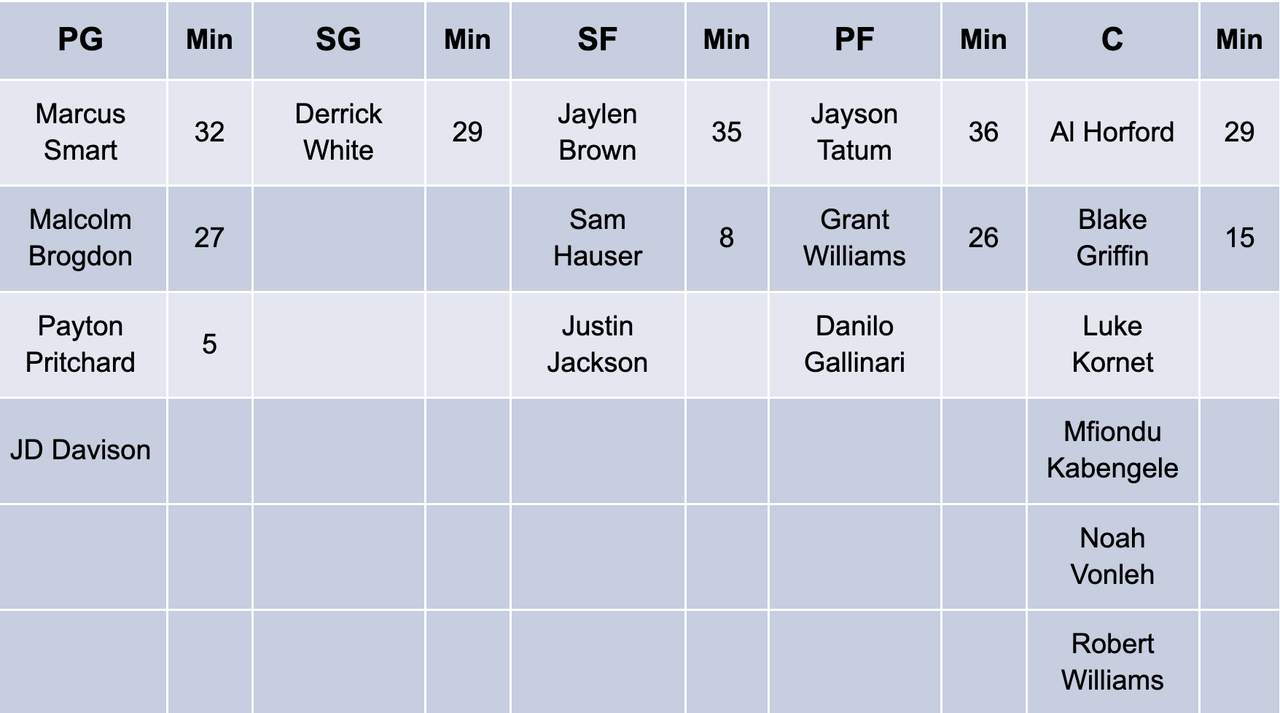
Best Case Scenario:
The Celtics are currently championship favorites. They lost in the Finals to the Warriors after winning Game One on the road, but they are still an ascending young team. Boston rode a league-best 33-10 record over their final 43 games to close to the regular season. Additionally, their two best players have not yet peaked, and they were able to retain all rotation players while adding Malcolm Brogdon for cheap. Boston played at a 62-win pace over the second half of last season, nearly won the title, and managed to improve. Placing them atop the league in the fall is deserved.
Worst Case Scenario:
This is also mostly the same Celtics team that started 18-21 last season. Their biggest variables are health concerns. Brogdon has missed at least 26 games in four of his last five seasons, Smart missed at least 20 games in two of three seasons, Horford is 36 years old, and Robert Williams has never played more than 61 games in a full season. In fact, he is already out for at least the first month of the season as he recently underwent an arthroscopic knee cleanup as issues from the end of last season have lingered.
The Celtics do not have the frontcourt depth to make up for these injuries, especially in lieu of Danilo Gallinari’s torn ACL. Issues adjusting to a new coach could reoccur sans Ime Udoka. Lead assistant Will Hardy is gone, and while Joe Mazzulla was also a finalist for the Utah job, the 34-year-old lacks experience. On paper, this is the title favorite, but they need to mesh with question marks on and off the floor. Their floor makes them contenders, but there is no guarantee they defend their Eastern Conference crown.
Is Malcolm Brogdon an asset as a sixth man?
Brogdon is a big addition to the Celtics. As a plus defender and rebounder who takes care of the ball and possesses the ability to score on or off the ball, he fits into nearly every lineup. He projects as the best lead guard for Boston offensively, and his scoring dynamism gives the Celtics an even larger margin for error against the league’s top teams.
Brogdon’s defect is why he was available for a first-round pick in the 20s and spare parts. He slid in the draft process due to injury concerns, and they have persisted throughout his career. A torn plantar fascia and quad made him miss large stretches early on, and varying levels of hamstring soreness forced him to miss nearly half of the Pacers' games in the last two seasons.
There is clearly a physiological imbalance in Brogdon’s lower body that keeps him from remaining healthy. When available, he should be a lower-end fantasy basketball asset with projected averages of roughly 13.5-4.0-4.5 in a reduced role. But producing in 60 regular season games is the most likely scenario with that reduced production. Boston hopes he is healthy for the postseason because he will be valuable when available.
Does Jayson Tatum have another level to reach?
Tatum went head-to-head with Kevin Durant in the playoffs and unquestionably outplayed him. Coming out of the Celtics’ playoff run, it might be fair to call him the best wing in basketball today. Tatum could have a compelling MVP case if he is able to continue his trajectory. He was already a top-seven scorer despite his shooting splits declining in a higher-volume role. Tatum was ninth in the league in usage, and shooting more or improving on efficiency could close the gap between him and the league’s elite scorers.
Additionally, he could take a leap in his facilitating. He exceeded four assists per game in 35.9 minutes per game last season, but he reached another level during the playoffs. Tatum posted 5.4 assists per 36 minutes in those 24 games as an even more focal distributor, and that role could carry into this season. If Tatum improves following a First Team All-NBA season while the Celtics match expectations, this could be his first MVP campaign.
Brooklyn Nets
Added: Royce O’Neale, TJ Warren, Yuta Watanabe, Markieff Morris, Alondes Williams (Two-Way)
Lost: Bruce Brown, Andre Drummond, LaMarcus Aldridge, Goran Dragic, Blake Griffin
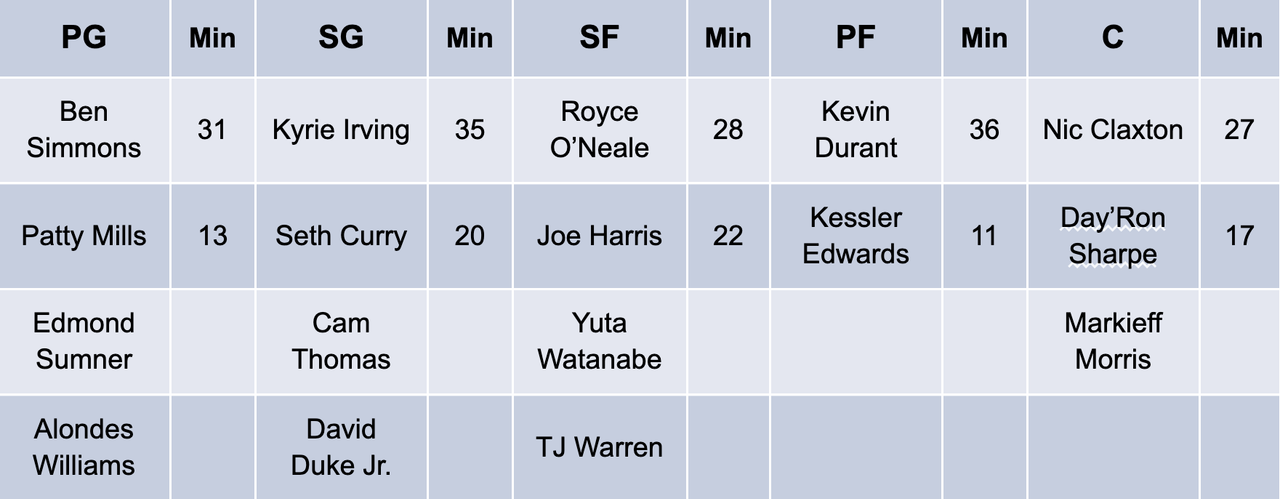
Best Case Scenario:
Kevin Durant is still one of the best five active players, and Kyrie Irving might be one of the five most talented players. With the offensive talent the duo possesses, adding a third star who excels defensively and as a distributor slots in perfectly, and that is what Ben Simmons adds. Seth Curry, Joe Harris, Patty Mills, and Royce O’Neale provide the main trio with excellent spacing. TJ Warren lit up the bubble at a true All-NBA level the last time he played, and if he is even 80% of that player, then he is an overqualified bench scorer. If the Nets figure out the right way for all this talent to mesh, then the nightmare of the last 12 months will be a thing of the past and this team threatens to contend.
Worst Case Scenario:
Steve Nash has his work cut out for him with this group after being mere months removed from Durant calling for his job. Nash is in Brooklyn because Durant and Irving rejected a strict X’s and O’s coach and preferred Nash, who has jokingly been called the “director of vibes”. Personalities also affect the basketball fit, and it is not clear how that plays out either. Offensively, it should work. There is concern that Simmons provides nothing offensively when off the ball, and managing that will be a challenge. This will be offset by the offensively talented role players in Curry, Harris, Mills, and Warren, who bring plenty of shooting and some shot creation to the table. But each of those players are defensive liabilities.
Fielding an average defensive unit could prove difficult. The centers might be cumulatively passable, but they are not good enough to cover up defensive issues on a high level. If the scheme is strong enough to get the best of the centers with consistent buy-in from the stars and a heavy dosage of Royce O’Neale, then an average defense is possible in theory. Asking for Nash to get Durant, Irving, and Simmons on the same page while making the imperfect personnel fit to work is arduous. This team presents the coaching challenge of a lifetime, and we are about to see if the director of vibes is up for it.
What does Ben Simmons’ role look like?
In theory, Simmons joining the Nets could accentuate the best in his game. Playing at the slowest pace in the league next to a heavy-usage big man never suited Simmons, who excels when pushing the tempo. Joining a team that desperately needs and values his defense and rebounding is also ideal, as he takes difficult defensive assignments and eases the load for a smaller team. The difficult part will be getting Simmons at his best. Much has been made about his unavailability, and after such a long layoff from play, it will take him some time to get back both physically and mentally. Those unknown variables cannot be overstated. And even if he recovers, this is not guaranteed to work.
Simmons can work on the ball and fit in this offense when doing so, but there is only a certain amount of time that two players as talented as Durant and Irving should be off the ball. For most critical offensive possessions, Simmons must find a way to function as a wing or big. This could prove extremely difficult if his jump shot has not improved massively. In the best-case scenario, Nash finds a balance in smaller lineups and Simmons runs the second unit a good deal, bringing out 14-6-6 averages with strong defensive stats. In the worst version, he is either unavailable or fits poorly with Durant and Irving that Brooklyn is better off closing with three other players instead. Simmons could provide value in fantasy basketball this season, but he is a massive risk for a somewhat limited upside.
Can Nic Claxton break out in a starting role?
Claxton has been handed a starting role for the first time. If he can regularly clear 24 minutes per night, then he is relevant in all fantasy leagues. Day’Ron Sharpe could be ready for a light role in year two after showing some ability in his rookie season, and Markieff Morris’ neck could be healed enough for a bit part. But that is likely all for either player. Additionally, some small lineups with Durant or Simmons at center could fly, but that time is even more limited on a nightly basis. The floor for Claxton’s minutes is likely about that 24-minute mark, with the potential for more based on the matchup.
Claxton has improved each year, a trend the Nets want to continue. As a non-shooter, Claxton’s fit could be iffy with Simmons at times. But his role will simply be setting screens, finishing, and anchoring the paint. The 23-year-old’s game is not perfect, but he should be able to execute in that role. Provided that Brooklyn does not execute a major move, look for Claxton to contribute roughly 10-8 with 2-3 combined blocks/steals per night and to be worth a late-round fantasy investment.
Charlotte Hornets
Added: Dennis Smith Jr., Mark Williams, Bryce McGowens (Two-Way), Theo Maledon (Two-Way)
Lost: Miles Bridges, Montrezl Harrell, Scottie Lewis, Isaiah Thomas, Arnoldas Kulboka
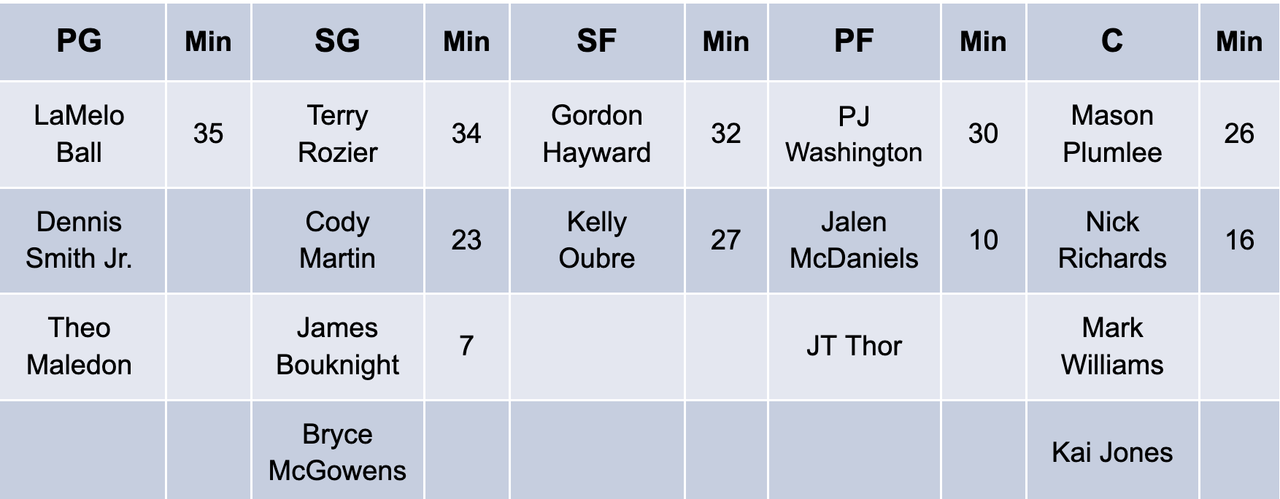
Best Case Scenario:
Charlotte is proceeding without Miles Bridges, who was often their most important player last year. But there could still be pieces in place to chase a play-in spot. LaMelo Ball has established himself, but fully solidifying his status as a perennial All-Star will help carry this team. Gordon Hayward finding a way to remain healthy while picking up the scoring slack that Bridges vacated can help get them there as well. The same applies to Terry Rozier, even if his injury history is not as checkered. If PJ Washington and Kelly Oubre can improve as volume shooters and Mark Williams can progress rapidly and establish himself as a defensive anchor that stabilizes Charlotte’s poor interior defense, then they won’t necessarily regress.
Worst Case Scenario:
Losing Bridges without internal improvements pushes this team back from the play-in potentially toward the top of the lottery. Hayward just posted his least efficient season since the Obama administration, and as he enters his age-32 season, there is a good chance he passed his prime. Rozier and Kelly Oubre could similarly fall below their 44% shooting with increased volume as well. Ball must create even more of the offense for himself, and they likely are asking him to do too much to keep this team around .500. If Washington remains merely an average shooter and defender while there are no answers in the middle, then there is too much on the shoulders of the guards and wings for this to be a productive season in the reboot of the Steve Clifford regime.
Does Gordon Hayward have a resurgence in him?
Hayward disappointed last season. He was in and out of the lineup due to injury, and when he played, he was not near as aggressive due to Charlotte’s superior offensive options. As a result, Hayward’s scoring fell below 16ppg for the first time since his third season. He was not as effective either, as his shooting percentages dipped despite lower volume. Often injured over the course of his 12-year career, it very much looked like Hayward was past his prime
Hayward needs to increase his production in Bridges’ absence. He provided brief flashes of his prime last season as a go-to scorer and effective secondary creator when COVID issues pressed him into a full starring role, and he has been pressed again. If Hayward remains healthy this season while improving his performance with volume fit for a $30 million player, that is critical to the Hornets managing to hover around .500 again. The need and opportunity for Hayward to provide around 20-6-5 nightly exist, and it is just a question if he has enough left in the tank.
Can LaMelo Ball be more aggressive off the dribble?
Even for a 20-year-old who just cleared 20ppg in addition to everything else, it felt like Ball could have taken on more of the scoring burden. With Bridges gone and the Hornets’ defensive effort set to be middling, Charlotte will need Ball to take another clear step to simply outscore everyone this season. Critical to that will be amplifying his aggression in half-court. It took a late-season surge for him to lead Charlotte in shot attempts last year as Rozier and Bridges nearly matched his output. His three-point volume was near-elite, and he could crack the top five for threes made with marginal improvement.
But Ball needs to get to the paint more to grow his game. Very nearly half of his field goal attempts last season were threes, attempting only seven two-point field goals nightly, many in transition. And when he got to the paint, Ball shot below league average at 50.1%. Aggressive paint drives in half-court sets could pay dividends for not only Ball but also the Hornets in the way defenses break down around a great passer. There are many reasons to believe that Charlotte takes a solid step back this season, but Ball seizing an even larger role and expanding on his first All-Star season will not be one of them.
Chicago Bulls
Added: Andre Drummond, Goran Dragic, Dalen Terry, Kostas Antetokounmpo (Two-Way)
Lost: Troy Brown Jr., Tristan Thompson, Matt Thomas, Tyler Cook
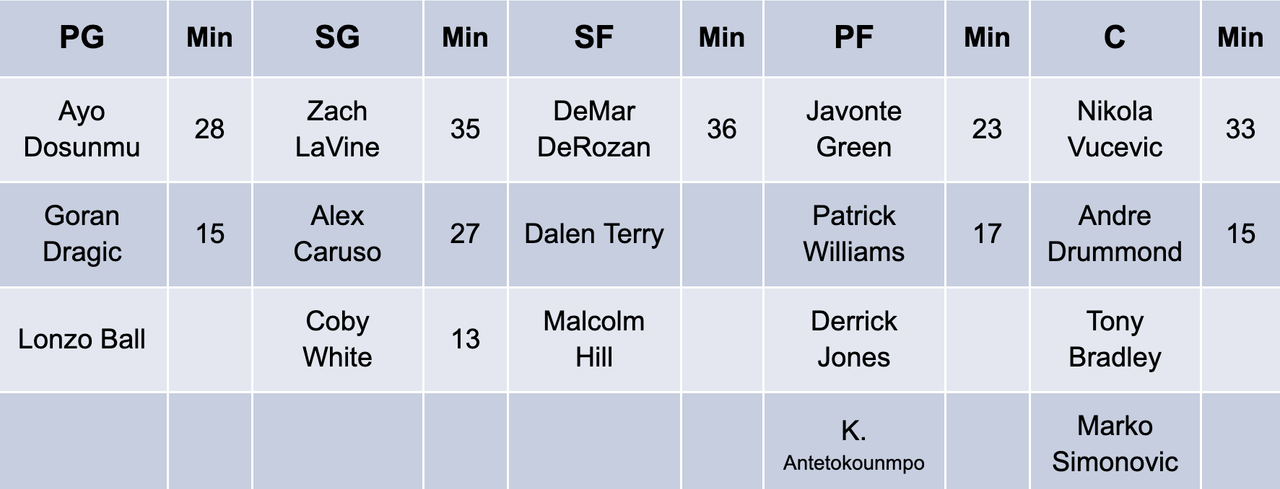
Best Case Scenario:
Injuries and fatigue undid the Bulls' season last year. Lonzo Ball, Alex Caruso, and Patrick Williams all missed at least half the season. Chicago leaned heavily on DeMar DeRozan, Zach LaVine, and Nikola Vucevic the more their depth was compromised. Over the course of 87 games, that trio collapsed under the increased burden. Improved health for Caruso, Williams, and hopefully, eventually, Ball should help aid DeRozan and LaVine to be their best in the spring. This team could have chased first in the East had those things happened last season, and the hope is for that to come to fruition this year.
Worst Case Scenario:
LaVine wore down as his season progressed last year, as the rigors of condensed seasons prior and his Team USA experience arose. He had arthroscopic knee surgery in late May to help alleviate the wear and tear but might not be his best five months later. DeRozan heroically peaked at age 32, but it is fair to question if he can extend his prime after 13 NBA seasons. Vucevic will also be 32 on opening night, and his deficiencies in space and overall reliability could be in question as he ages out of his prime. Ball’s knee issues are fully in question as the season is about to begin, and he might not be able to play this season at all. Williams could merely be a Royce O’Neale-esque player in year three, and Alex Caruso and Ayo Dosunmu will fill roles, but not fully move the needle. So much of the Bulls' season relies on their big four, and there are definite cracks in the foundation that could undo them.
What’s going on with Lonzo?
Now 39+ weeks removed from being shut down last January, Ball recently announced that he still couldn’t run or jump, and he underwent another arthroscopic knee surgery. Ball will be re-evaluated in mid-November for a clearer return timeline, and he projects to miss at least a full calendar year. This is an immense disappointment for Ball, and the priority for the organization has shifted from getting him back early in the season to just making sure this isn’t a permanent career setback.
If Ball returns, he could be set for a more limited role if heavily restricted. Expect Dosunmu, Caruso, Dragic, and White to all receive more playing time with Dosunmu and Caruso likely in the highest minute load roles. Additionally, DeRozan and LaVine should have higher usage on-ball roles in the interim as well. The other Bulls will shoulder the burden while Ball remains out, but he needs to return somewhere near full strength this season for them to threaten in the Eastern Conference.
Can DeMar DeRozan stay at his peak at age 33?
DeRozan deserves a world of credit for his work ethic because there are very few cases where a player continues to improve over the course of 13 seasons. Following three productive Spurs seasons, he got to Chicago, where many panned his large contract. It took merely a month to silence critics as DeRozan pieced together his third All-NBA season in arguably his best season to date.
DeRozan surprised as the Bulls’ alpha scorer last season, taking more field goal attempts than LaVine or Vucevic. His 27.9ppg was a career-high, a mark he achieved on a near career-high 50.4% from the field. His rebound and assist numbers remained at Spurs levels as he pieced together the finest statistical season of his career. He faded down the stretch as the Bulls did, but he was a legitimate MVP candidate for much of the year.
The Bulls’ hierarchy favors him and keeps his statistical floor very high. Even if the assists remain below five and potentially reduced volume or an aged-related five percent reduction in overall play occurs, he should stay in the range of 26-5-4.5 and another All-Star berth.
Cleveland Cavaliers
Added: Donovan Mitchell, Ricky Rubio, Robin Lopez, Raul Neto, Isaiah Mobley (Two-Way)
Lost: Lauri Markkanen, Collin Sexton, Rajon Rondo, Moses Brown, Ed Davis, Brandon Goodwin
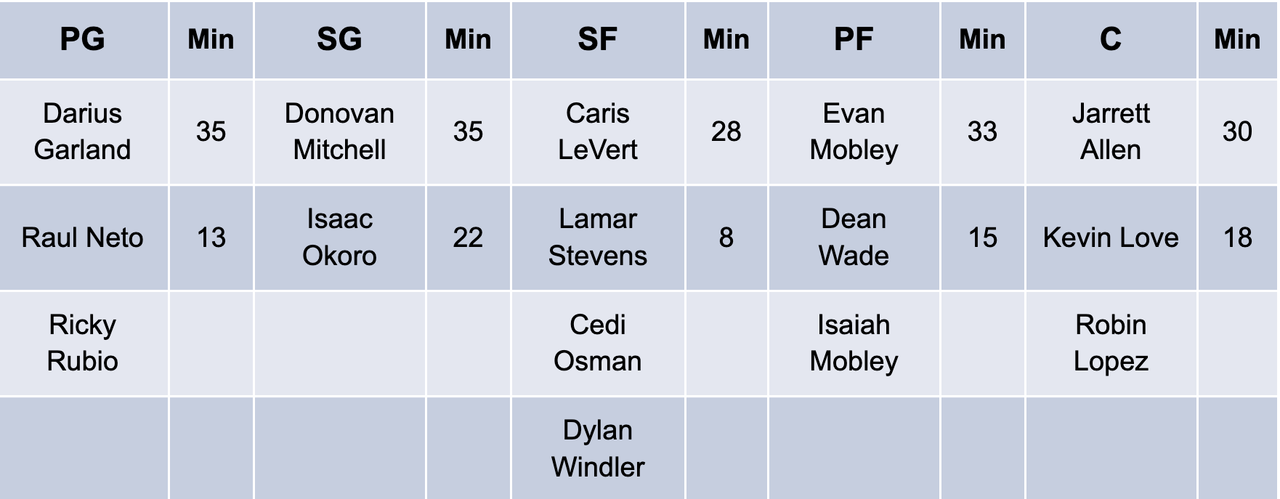
Best Case Scenario:
The Cavaliers went 44-38 last season despite enduring significant injuries. A clear lack of shot creation outside of Darius Garland limited the ceiling of last year’s team, and they ranked 20th in offensive rating. But their fifth-ranked defense buoyed them and remains intact. Adding a 26ppg scorer raises their ceiling, and Mitchell and Garland should prove to be a seamless dynamic duo offensively. A general guideline for a potential contender is ranking top five in both offensive and defensive rating, and the Cavs could get there with Mitchell.
Worst Case Scenario:
Making the leap to a contender is no guarantee. Mitchell has generally been a negative defender, and the Cavaliers now have two of them in their backcourt. If Caris LeVert starts, then they would have three. There will be diminishing returns on the impact of their secondary creators, as they are below-average shooters playing off Mitchell and Garland. Similarly, Kevin Love doesn’t move the needle if his scoring is less needed as well.
Additionally, the Cavs’ offense, projected to feature three starters with below-average three-point shooting efficiency, may not click as expected. While there may be a path for the Cavs to reach the highest ends of the league on both ends, there is also a path for them to reach a middle ground on either side of the ball instead. Cleveland still has to prove to be more than merely a good team.
What will Darius Garland’s production resemble?
A player of Garland’s youth and skill will continue to improve, but his numbers may not reflect that this season. In projecting Garland’s stats, acknowledge how ideal last season was for him to generate numbers. Collin Sexton going down last season elevated Garland from the secondary Cavs option to the primary, a role he should acquiesce playing next to Mitchell. Losing Ricky Rubio placed even more emphasis on Garland to create for others, which led to his assists rising from about seven to nine with regularity.
Not only will Rubio and LeVert return to demand reps on the ball, but Mitchell should be filling that role more than Sexton ever did. With fewer reps and decreased shooting volume, the ceiling for the stats that Garland provides this season will decline. His scoring decreasing to about 20ppg and assists declining to about six-to-seven per night is the most likely result. Even if Garland is better in year four, an improved Cavs unit feels likely to prevent linear statistical growth.
What will Donovan Mitchell’s stats look like on his new team?
Mitchell accepted increasingly expanded offensive roles for the Jazz over time. From his rookie season on, this was the case as his game progressed and as Mike Conley, Joe Ingles, and Bojan Bogdanovic aged out of their primes. His 32.9% usage rate ranked fifth league-wide last season, but he will likely not be able to continue at the same rate. The Cavs have more offensive talent than the Jazz ever did, and Mitchell will not be asked to take on the same workload as a result. Due to purely volume reasons, his counting stats will decrease in Cleveland.
There are some positives that a smaller offensive role can provide Mitchell. His shooting efficiencies have not impressed with more forced looks, and they figure to recover. But his points and assists will almost certainly decline. His usage rate falling from 33.0% to around 28% is likely, and a five percent hit to his scoring would leave him around 24.6ppg. His assists also are likely to remain below his Utah mark of five per game. Mitchell’s counting stats will not fall off harshly, but there is a lower ceiling and floor for his production. Expect a stat line around 24.0-4.0-4.5 for his new team.
Detroit Pistons
Added: Bojan Bogdanovic, Alec Burks, Nerlens Noel, Kevin Knox, Jaden Ivey, Jalen Duren, Buddy Boeheim (Two-Way)
Lost: Jerami Grant, Saben Lee, Kelly Olynyk, Frank Jackson, Luka Garza, Jamorko Pickett, Carsen Edwards
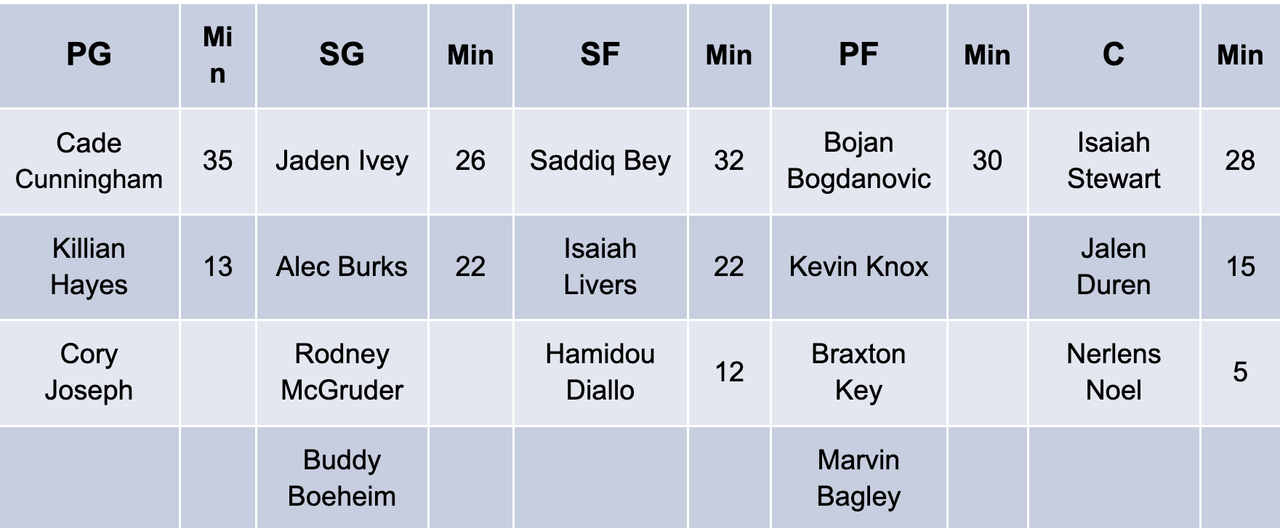
Best Case Scenario:
Detroit might be best off making one more top-five pick, but if their young talent plays up to its potential, they could avoid the lottery altogether. Acquiring Bojan Bogdanovic signaled their attempt to chase a play-in spot. Cade Cunningham has progressed and could be on the verge of playing at an All-Star level in year two. Isaiah Stewart and Saddiq Bey have proven to be capable rotation players, and incremental improvements would solidify them in this league. Isaiah Livers and Killian Hayes can prove themselves as role players, and Jalen Duren could offer more dynamic center play. This organization also believes in Marvin Bagley. Finally, Jaden Ivey’s scoring and defense translating as a rookie could push this young team over the top. The vets could help accelerate the Pistons into that play-in conversation if everything breaks right.
Worst Case Scenario:
The Pistons will be positioned to step into the top of an appealing lottery if they falter. More so than wins and losses, they are looking for each young player to improve. Cunningham needs to progress before becoming an effective centerpiece. Ivey has tools, but his current flaws might make him an imperfect fit in his rookie season. Bey shot below 40% from the field as his role grew in his second season, and his game could plateau as he now nears his mid-20s. Stewart is a plus-rebounder, but he might not anchor a defense and his offensive game could remain very limited. Hayes and Livers could be out of the league in two years. If all the downsides of their young players occur and they win just enough games to end up in the mid-lottery, then this could potentially be a lost season.
Can Jaden Ivey be an immediate secondary offensive threat?
Ivey’s game is tailor-made for the NBA, as his athleticism allows him to thrive in space. His fit alongside Cunningham works in theory, but in practice, it might take some growing pains. Given Cunningham’s strength and Ivey’s weakness as a distributor, the rookie should be expected to work exclusively off-ball. Ivey’s jump shot will be crucial, and it is fair to question that aspect of his game. While he converted 35.8% from deep as a sophomore, his form and approach require examination. His set shot takes a long time to set up and get off, and NBA defenders will not allow Ivey the space granted by college defenders. While heavier second unit usage minutes could work, those also could be limited because of the development he needs to make as a distributor.
The rookie's speed and cutting will undoubtedly allow him to flash, but he’ll need time to develop into a volume scorer. Detroit could be better off leaning on Bey, Bogdanovic, and Bagley to do more offensive lifting next to Cunningham, allowing Ivey time to increasingly assert himself. Depending on how much they value winning in the first couple of months, they could also end up utilizing a big lineup, Burks or Cory Joseph closing games. While it is not necessarily a knock to Ivey long-term that he shouldn’t be expected to be a 20ppg scorer as a rookie, the most likely scenario is that he averages between 12-14 points with limited non-scoring stats.
How valuable can Cade Cunningham be this season?
The role that Cunningham plays is just as vital to his team’s success. His rookie season backs this up. Cunningham posted 15.4-5.4-5.1 on 39.6% from the floor and 32.6% from three over the course of his first 35 games. But the optimism stems from how Cunningham adjusted. Over his final 21 games, he averaged 21.0-5.8-6.4 on 45.2% and 28.9% splits with nearly a combined two blocks/steals per night, establishing a baseline of expectations.
If Cunningham hovers around 21-6-7 per game, then he is likely a bit underrated in fantasy basketball. While the Pistons added some scoring to ensure Cunningham might not have as green of a light, he is still the lead offensive hub. He is likely thrust into a truer point guard role this season. This should cause his assists to rise above seven per game and position him to potentially match his 30.3% usage rate over his final 21 games. If his role is larger and progression irons out some of the deep shooting deficiencies, then 21.0ppg is achievable.
Indiana Pacers
Added: Daniel Theis, Aaron Nesmith, Trevelin Queen (Two-Way), Bennedict Mathurin, Andrew Nembhard, Kendall Brown (Two-Way)
Lost: Malcolm Brogdon, Ricky Rubio, TJ Warren, Duane Washington Jr., Lance Stephenson, Gabe York, Nate Hinton
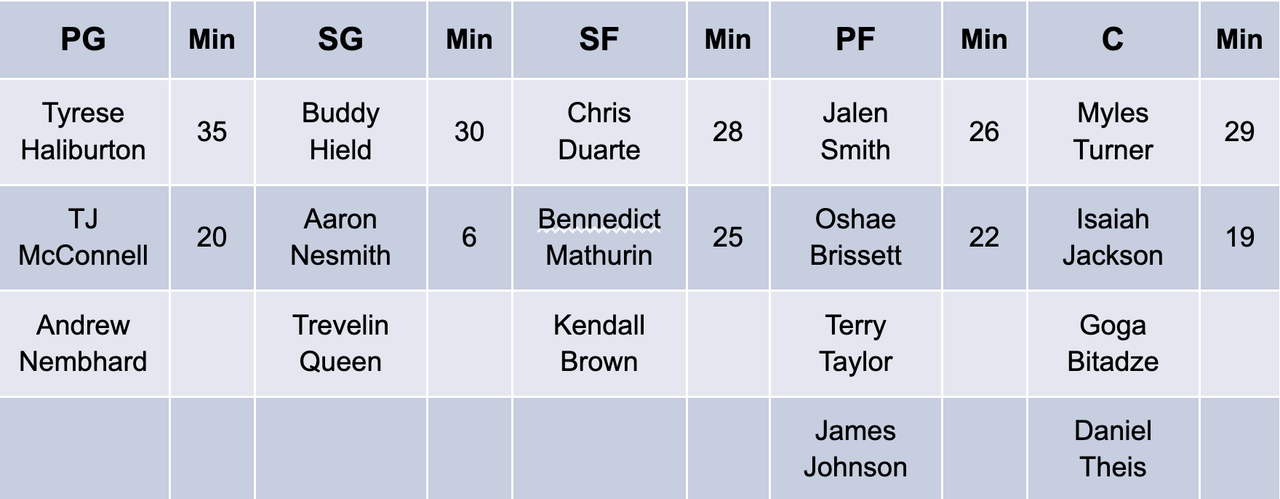
Best Case Scenario:
The best-case Pacers team is a version where they position themselves to add a franchise player at the top of the lottery. It’s ideal if they get there while adding long-term assets for Myles Turner, Buddy Hield, and TJ McConnell. Turner’s departure would create larger roles for Isaiah Jackson and Jalen Smith, and one or both of them establishing themselves as frontcourt assets would be big. Additionally, Chris Duarte and Bennedict Mathurin filling three-and-D roles, with some ability to create off of the dribble, on the wing is even more vital. Tyrese Haliburton really took off after joining the Pacers, and if he can sustain that in more competitive contests, then he is an ideal second piece moving forward. Drafting a franchise player with Haliburton and Mathurin flanking him, Duarte filling a role and the young big men in place could accelerate the turnaround.
Worst Case Scenario:
There is a version of these Pacers that chase a play-in. The Pacers can be a below-average team when Turner, Hield, and McConnell are filling their veteran roles. If Indiana doesn’t recoup assets for that trio, then that is a setback. If the Pacers do so without Halliburton sustaining his play from the end of last season, the outcome worsens. Turner staying stunts the growth of the young big men; Hield disrupts the growth of Mathurin and Duarte. This should be all about building forward for the Pacers, not struggling to remain in the middle.
Can Tyrese Haliburton sustain his post-All-Star break pace?
The Pacers were middling after the All-Star break, but they were fun and competitive thanks to Haliburton’s contributions. The 22-year-old flourished with the keys to the offense: in 18 games without Malcolm Brogdon, Haliburton averaged 18.6-4.2-10.1 and 1.8 steals per game. More impressively, he did so while shooting 50.9% from the field and 45.7% from three. The key now will be playing up to this level during more competitive games, and also doing so when everyone knows he is the focal point of their offense.
Haliburton appears poised to break out with an All-Star-level performance over the course of a full season. There is a reason for optimism that he can match those numbers and finish top five in assists as a result. He is smart about his shot selection, and his shooting numbers will reflect that. But the odds that he can maintain 50% from the floor and especially 45% from three are extremely low in a larger sample. If Haliburton can broach those shooting numbers this season, 18-4-10 averages are achievable.
Can this be a career season for Buddy Hield?
With Indiana having a need to generate offense, Hield could masquerade as a good fantasy basketball option. While Haliburton’s play caught the headlines after the All-Star break, Hield also played the best all-around ball of his career. The scoring numbers were nice—with 18.2ppg on passable efficiency across a 26-game sample. But the non-scoring numbers were a bigger surprise. A career shooting specialist who had been averaging 4.0 rebounds and 1.9 assists, Hield jumped up to 5.1 boards and 4.8 assists nightly after arriving in Indiana.
If Hield can port similar late-season numbers into this season, then he is undervalued for fantasy basketball. There is little proven shot creation on this roster after Haliburton, and the burden could fall on Hield again. His scoring stats enduring for most of this season feel guaranteed while the Pacers are trying to compete. In all lineups where McConnell is not playing with the starters, Hield also likely works as a secondary distributor. A similar opportunity remains and sticking around 18.0-5.0-4.5 could be in play until after the All-Star break. There is a risk in trusting Hield for all 82 games this season, as a trade or increased opportunity for Mathurin and Duarte could decrease his value. But at this moment, everything is aligned for Hield to have his most productive all-around play for a 60-game stretch.
Miami Heat
Added: Nikola Jovic, Jamal Cain (Two-Way), Dru Smith (Two-Way)
Lost: PJ Tucker, Markieff Morris, Mychal Mulder, Javonte Smart
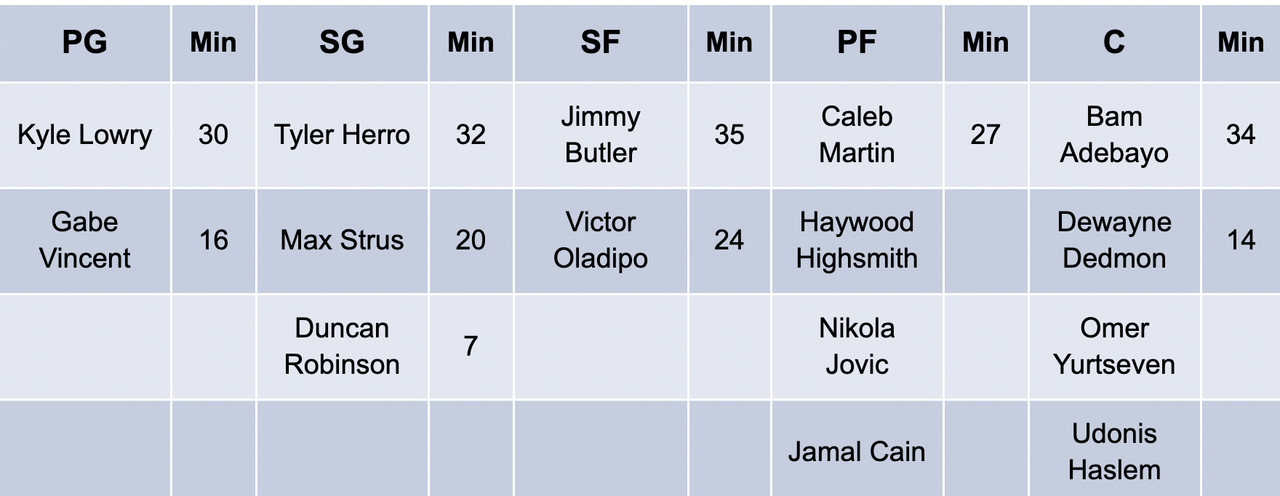
Best Case Scenario:
Had Kyle Lowry been healthier last season, there’s no telling where their season would have ended. If Lowry has a smoother season and staves off regression along with Jimmy Butler, then Miami can threaten again. Continued growth from Tyler Herro and Bam Adebayo would make them more of a contender, as the duo can help them break into the top ten of offensive efficiency. They will be getting a full season from Victor Oladipo for the first time too. While losing PJ Tucker hurts, Caleb Martin could roughly emulate his role. If Butler plays heavier minutes at power forward, then the decision to not replace Tucker makes sense. Overall, Miami has felt like they have been close for three seasons and still stand a chance to break through with this group.
Worst Case Scenario:
The Heat have $66 million on the books this season for two aging stars. The 36-year-old Lowry’s scoring fell off sharply in year one of an $85-million-dollar deal, and he averaged 9.5ppg in two playoff games prior to his hamstring strain. The 33-year-old Butler also showed his age last season, embracing regular rest and playing just 57 regular season games despite his worst injuries being a bruised tailbone and an ankle sprain. He has a lot of miles on him from coach Tom Thibodeau and has averaged over 33 minutes per game for the last decade. Butler does likely play at a near-prime level this season, but his mileage and the history of how poorly non-shooters age work against him. The bottom line is this: the supporting cast will likely not be much better than last season following Tucker’s departure and 53 wins earned them the one-seed. If the best-case scenario is battling for a top-four seed and the second round, then where could the downside be from there?
Does Victor Oladipo prevent Tyler Herro from scoring 20ppg again?
Herro’s scoring has increased during each season while his shooting splits have improved, and he has shown incremental defense and playmaking developments. While Herro could improve again this season, it doesn’t guarantee enhanced stats. Last season’s baseline—playing 32 minutes per game on star volume—will be difficult to match this season. His potential usage as a starter would be more difficult to match than it was in a bench role, where his usage peaked. This could be doubly true if the preseason rumors about Adebayo’s aggression materialize. Additionally, Herro achieved a 28.8% usage rate as Butler missed 25 regular season games, Lowry sat 19, and Oladipo was sidelined for 74.
While Butler and Lowry will allow Herro opportunities as rest is inevitable, it is the full return of Oladipo that should hold Herro back. Oladipo signed a two-year deal to return to Miami that includes a player option, so he will be fighting to stay on the floor as much as possible. With Oladipo available and Lowry largely not during the postseason, Herro’s usage declined to 25.2% as he dealt with a groin strain. If Herro doesn’t start, then sharing the floor with Oladipo for peak-usage minutes could be especially troublesome. Herro should outpace Oladipo and Adebayo as the secondary scoring option to Butler, but overall volume reductions should keep him between 17-18 ppg in all likelihood.
Is Kyle Lowry a worthy fantasy basketball investment?
There were periods when Lowry needed to play a starring role for the Heat when Butler was out, and his overall assist numbers of 7.5 per game did not represent a decline. But Lowry was playing more of a classic point guard role for Miami: his shooting volume nearly fell to below ten shots per game, and over 60% of his attempts were threes. He largely initiated offense and took open threes when presented, and he did not force his own look with frequency. Despite making 22 starts without Butler, Lowry finished the season averaging 13.4ppg, nearly four points lower than what he averaged during his final Raptors season.
There could be a further decline in Lowry’s stats this season. He averaged over 33 minutes per game last year and had mostly positive injury luck. As a result, his body did not hold up during the playoffs. It makes sense for Miami to lessen Lowry’s regular-season workload to preserve him for the playoffs. Exceeding a 30-minute average or 60 games might be off of the table. The strengths of Miami’s other options might also lessen Lowry’s facilitating workload, increasingly relegating him to a spot-up shooter. Potential averages of 12.0-4.5-6.5 in roughly 60 games are not a terribly valuable fantasy option, and you could be better off letting others invest in Lowry based on the name value.
Milwaukee Bucks
Added: Joe Ingles, MarJon Beauchamp, AJ Green (Two-Way)
Lost: Rayjon Tucker, Lindell Wigginton, Luca Vildoza
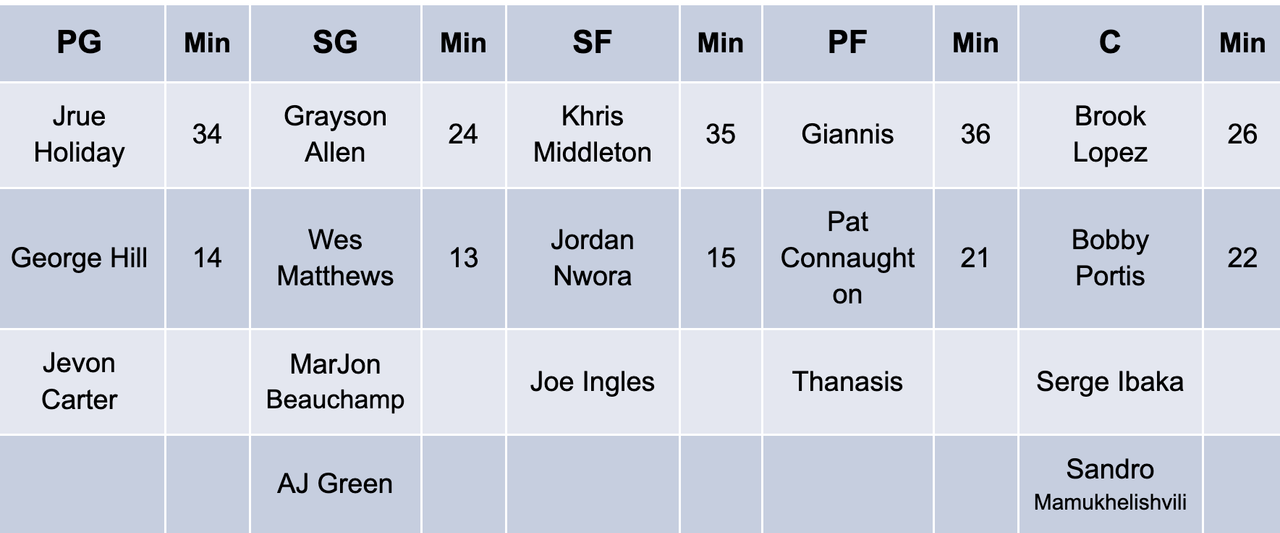
Best Case Scenario:
One moment in the first round undid the Bucks’ chances of repeating as NBA champions. Khris Middleton sprained his MCL, and they still took the Celtics to seven games. The Bucks worked to retain their core in the hopes that better health will pay dividends. Giannis Antetokounmpo will anchor them and force championship contention. Brook Lopez showed signs of his age last season but returning to his 2020-21 form would bolster Milwaukee’s chances. Jrue Holiday and Middleton continuing to play at All-Star levels while the rest of the roster accepts and fills their roles will make the Bucks tough to beat. Joe Ingles eventually adding a steady veteran presence and one of Jordan Nwora or MarJon Beauchamp emerging at the end of the rotation could also help put Milwaukee over the top come June.
Worst Case Scenario:
If Milwaukee falters at season’s end, it is because the infrastructure around Giannis began to deteriorate. At age 32, Holiday’s ability to defend and create separation could be further compromised. Lopez, 34, could further decline and become a bigger liability in space. George Hill provided zero spark for them last year and should remain ineffective. Ingles fell off in a big way at age 34 and then tore his ACL—his days of making a positive impact could be over. Additionally, coach Budenholzer’s defensive scheme has only proven to be increasingly outdated each season. The Bucks have a sure window with their main core aging out of their primes, and the concern is that they missed the end of their window when Middleton sprained his knee in the playoffs.
Is Bobby Portis or Brook Lopez the preferable fantasy basketball asset?
Portis will make a good number of starts for Lopez again this year since Lopez will not be an everyday player. These starts, plus the rare power forward starts when Giannis is out, will give Portis clear windows to raise his numbers. Depending on his total starts, Portis can exceed his baseline 10.8-8.2 stats in the 20-24 minutes he gets as a reserve. Lopez’s floor, barring major injury, projects around at least 60 games. Given that he was ramping up during the regular season, we’ll extrapolate his playoff stats to gauge future production. Those averages of 10.6-5.9 and 1.5 blocks should be fairly stable and do represent a slight decline from his last fully healthy season.
Even if he is not the primary starter, Portis looks to be a slightly more valuable player than Lopez. His rebounding more than makes up for Lopez playing a bit more on a game-to-game basis and posting superior block stats. Depending on the depth of the fantasy league, Portis might be best deployed as an add when he starts, but he offers steady, low-end value regardless. His upside in starting spots exceeds Lopez’s, and if they are comparable game to game, then he deserves an edge.
Can Giannis keep progressing?
Giannis Antetokounmpo is unlike anything we have seen. He improved last season coming off two MVPs and one Finals MVP. He got to the line at a career-best rate of 11.4 attempts per game and converted a respectable 72.2%, rectifying his biggest deficiency. He also manned center with Lopez out and posted career-best rebound and block numbers. While Giannis is arguably the top player in the league, his progression as a player might not be complete at 27 years old.
Sharing the floor more with Lopez compared to Portis could cause his rebounding numbers to rise again, potentially up to 12 per game where he can contend to lead the league. He can also get to the line with greater frequency and improve on his 72.2% rate, as teams often have little recourse but to foul him in the paint. His facilitating has stagnated over the last few seasons, but seizing more control while cutting down on turnovers could lead to a slight bump in assists. Finally, there is the nuclear option that could always make Giannis unstoppable: if his outside jump shot can be almost average—if he makes teams pay for sagging off him and hits more than 30.0% of his 3.6 looks from deep per night—then his level of play will truly be scary. As bizarre as it is to say for a player so accomplished, there is a good chance he hasn’t offered his best.
New York Knicks
Added: Jalen Brunson, Isaiah Hartenstein, Svi Mykhailiuk, Trevor Keels (Two-Way)
Lost: Kemba Walker, Nerlens Noel, Alec Burks, Taj Gibson
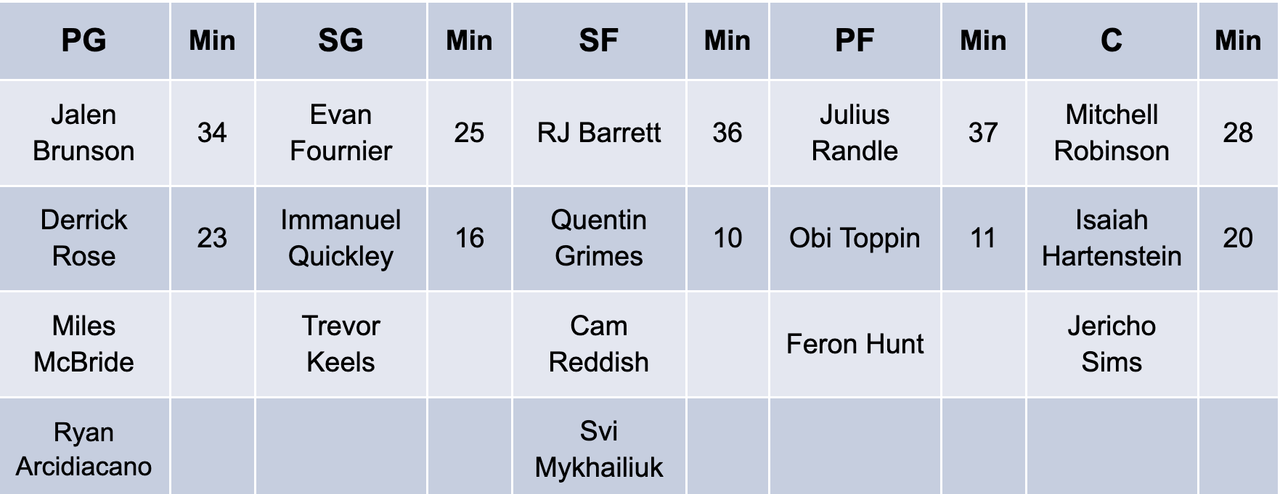
Best Case Scenario:
How much the Knicks paid for the services of Jalen Brunson can be criticized, but their roster improved. At the cost of Kemba Walker, Alec Burks, and Nerlens Noel, New York has Brunson and Isaiah Hartenstein as replacements. Derrick Rose returns from injury to fill the sixth-man scoring role as well. The Knicks regressed last season, but they finished only four wins worse than their “breakout” season the year before. With Brunson and Rose effectively both being added to a roster that has more talent than minutes available for the first time in a decade, the Knicks can reverse course. The talent to post an average offense exists, and with coach Thibodeau at the helm, an above-average defense is likely. Last year was a disappointment for the post-hype Knicks, but a rebound for the post-post-hype Knicks is entirely feasible.
Worst Case Scenario:
What made this past season disheartening was not necessarily the wins and losses. It felt like personalities didn’t fit. Randle’s relationship with the home crowd turned ugly, and this happened while his play in nearly every regard declined. If Randle’s lone All-Star appearance was an outlier and Thibs’ message is increasingly lost on this group, then this should make for a very average team. Additionally, Evan Fournier regressed last season, and Obi Toppin, Immanuel Quickley, Quentin Grimes, and Cam Reddish will all be dissatisfied with their roles. It’s easy to see how the bad vibes continue.
Was Julius Randle just an all-time contract year outlier?
In the 2018-2019 and 2019-2020 seasons, Randle averaged a combined 20.5-9.2-3.1 on 49.4% shooting from the floor and 30.8% from three. Last season, Randle averaged 20.1-9.1-5.1 on 41.1% and 30.8% from the field. A slightly greater distributing role and an average of five more minutes per night boosted his assists, but the greater offensive role tanked his shooting numbers. His defense—which was never good—reached new lows. The Randle of last season was the same player that accepted an $8.8 million salary from the Pelicans as the one who signed on for $117 million from the Knicks. He just had a worse attitude.
The version of Randle that averaged 24-10-6 for New York in his All-NBA season would not post those stats for this year’s Knicks. That is a function of increased surrounding talent—Barrett and Quickley emerging and swapping Elfrid Payton for Brunson. Even with the same level of play, lesser volume would keep Randle around 20-10-4. He would also fit in cleanly with this talent, as his 41.1% shooting from three would suggest. If the big man can shake off a nightmare season and return to that level of play and touch from deep, then those 20-10-4 marks are attainable. But if he is the player he has been in his prime for every other season, prepare for another statistical reduction. Anticipate 17.0-9.0-3.5 to be the most likely scenario.
Can RJ Barrett become a true All-Star-level player?
Barrett’s progression was the bright spot in a largely ugly Knicks season. In the 29 games from the start of the season through the New Year, Barrett averaged 15.0-5.6-2.2 nightly on 40.0% from the field and 32.5% from three. With him as their franchise player, it was extremely discouraging to see negative regression at age 21. But to Barrett’s credit, he turned his season around. While a lot of his late-season numbers came when the Knicks had few offensive options and Thibodeau played him 37 minutes per night, he responded in a big way. Over the course of his final 40 games, Barrett averaged 23.7-6.1-3.6 while his shooting numbers improved within the larger role. For the first time, “All-Star potential” became realized in his young career.
Barrett is not likely to emulate 23ppg or 3.6 assists this season. The additions at point guard will decrease his shooting volume and overall role as a distributor. Team success and counting stats should not equal the first All-Star nod for Barrett this year. But that doesn’t mean his game fails to progress. Lesser volume should keep him just south of 20ppg, but it should allow him to be north of 45% from the field and 36% from three. And while assists are less likely, his ability to see the floor and create for others can continue to evolve. There is All-Star potential with a key injury on the Knicks this season if he can step up and buoy them in a big way while that happens. But even if that specific scenario doesn’t happen, Barrett made the steps needed for All-Star consideration.
Orlando Magic
Added: Paolo Banchero, Kevon Harris (Two-Way), Caleb Houstan
Lost: Robin Lopez, Ignas Brazdeikas
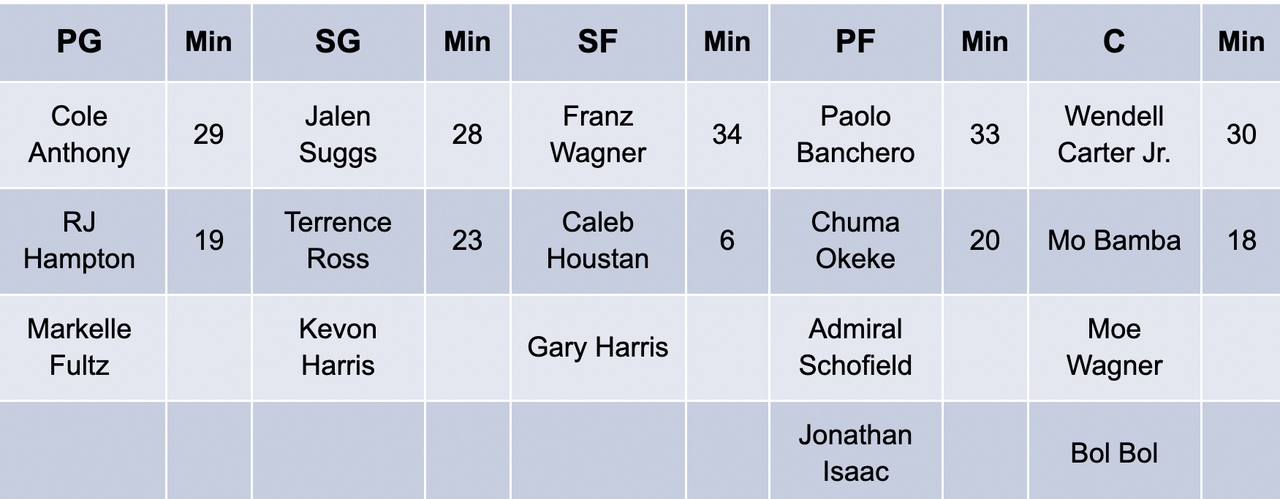
Best Case Scenario:
The best-case version of this team could surprise despite expected growing pains. Cole Anthony progressing as a point guard instead of a natural combo scorer will help even them out. Markelle Fultz improving his touch from deep could similarly help. Jalen Suggs continuing to develop as a two-way role player could make him the major piece of their rebuild. Wendell Carter Jr. progressing as a pick-and-roll finisher and shooter while improving as a defensive anchor will cement him in as a similar piece. Franz Wagner flashed more ability to create as a rookie than anyone expected, and he and rookie Paolo Banchero could be the focal offensive fulcrums for the next decade. The pieces exist for Orlando to be a shockingly deep team that turns around its rebuilding effort quickly.
Worst Case Scenario:
It is fair to question how many of the current Magic players become viable starters. Anthony could be more suited as a sixth-man combo guard than as a lead point guard. Fultz has lead guard ability, but his shooting remains a major issue. Suggs could take on more playmaking responsibilities, but his assist-to-turnover ratio from his rookie season suggests he is not ready for such a role either. He was a standout defender, but his shooting was nightmarish, and his finishing was suspect, too. Suggs needs to progress on those in a big way before he is truly a deserving starter. Isaac just missed two full seasons and it isn’t clear what to expect of him as well. Additionally, Hampton and Okeke also have not proven that they have any singular standout skill. There is also a risk that Banchero resembles Marvin Bagley more than the lazy Duke comparison lends itself to on the surface. Wagner, Carter, and Banchero should establish themselves as the frontcourt of the future, but the infrastructure around them may not be in place.
Is Paolo Banchero an immediate offensive centerpiece?
Had many teams other than the Magic won the draft lottery, Banchero may not have been the first overall pick. Chet Holmgren and Jabari Smith have safe floors as high-level role players, but Orlando valued Banchero’s ceiling as the most likely prospect to be an offensive centerpiece. With many pieces in place, the Magic still lacked this key variable and valued that the most. While Anthony can fill it up, Carter Jr. has developed into a high-level finisher and Wagner can develop into a 20-5-5 player, Orlando needs Banchero to realize his potential.
What makes Banchero’s potential as a go-to scorer real goes beyond his finishing. His shooting improved as Duke’s season progressed, and he could be an average shooter outside of the paint immediately. The 19-year-old’s passing is also ahead of its time, and he took on more of a distributing role as it became evident that he was Duke’s best facilitator. It could take some time for him to fully assert himself as a distributor and unlock that piece of Orlando’s offense, but look for him to take on increased reps as the season develops. The first overall pick likely opens the first month of the season averaging about 15-7-3, with the potential for his scoring and assists to ramp up month-by-month as he finds his way.
Should Markelle Fultz or Cole Anthony start at point guard?
Anthony is cheaper and younger than Fultz, and we have not seen the best of his game. He offers more as a shooter and shot creator for himself, which should be valued until their frontcourt takes bigger control of their offense. Additionally, Suggs will likely start at shooting guard, and Anthony allows them to maintain much more optimal spacing. Anthony’s facilitating and defense are concerning, but he has been cast in a role far beyond his ability. With another year of maturation and a more reasonable role, Anthony could show all-around point guard ability in a way that he has not been able to date.
Fultz was limited after returning from a 14-month layoff last season, but he played career-best basketball on a per-minute basis. His per-36 stats of 19.5-4.9-9.9 and 2.0 steals suggested a greater overall impact than Anthony, and he did so after a lengthy absence. Fultz also converted 23.5% of his three-point attempts last season, and that is why he might not be their starter. He recently fractured a toe and missed training camp, further complicating the Magic’s decision. But when he eventually returns, Fultz brings comparatively much better defense, and pairing him with Suggs would create potentially the league’s best defensive backcourt. Additionally, starting Fultz would place Anthony into a better-suited scoring sixth-man role. We will need to wait for Fultz to return to see this position battle resume, but it is worth monitoring.
Philadelphia 76ers
Added: PJ Tucker, De’Anthony Melton, Montrezl Harrell, Danuel House, Julian Champagnie (Two-Way)
Lost: Danny Green, DeAndre Jordan, Paul Millsap, Myles Powell, Charles Bassey, Isaiah Joe
Potential Cuts: Michael Foster
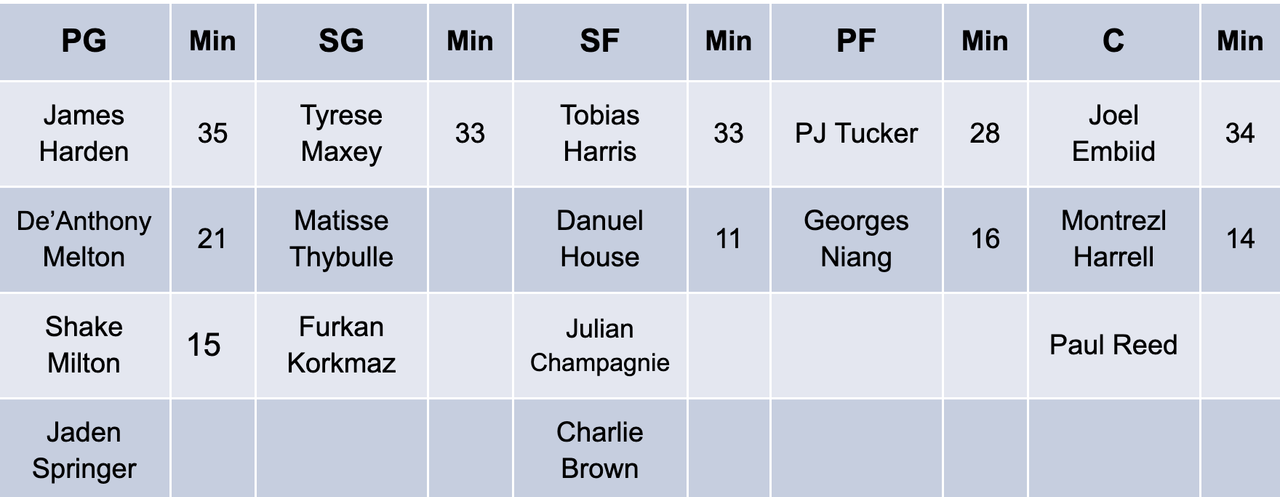
Best Case Scenario:
The 76ers ceiling was raised with the acquisition of James Harden, and it nearly paid off during the playoffs. With improved health, they could have had a real shot of making the NBA Finals. This 76ers team will be more equipped to make a run thanks to a shrewd offseason from President of Basketball Operations Daryl Morey. First, he flipped Danny Green’s contract and the 23rd pick for De’Anthony Melton, a useful backup guard. Second, he leveraged his relationship with Harden to entice him into opting out of the last season of his deal and accepting less money. This resulted in adding two key depth pieces in PJ Tucker and Danuel House. The pieces are in place for the 76ers to make a run this season, and the process may finally be complete.
Worst Case Scenario:
Harden’s level of play fell off last season, as a lower usage rate and a much slower pace in Philly caused his numbers to fall in a big way. The 33-year-old posted 21.0-7.1-10.5 on 40.2% from the floor and 32.6% from deep for the 76ers, a far cry from his peak production. Tobias Harris’ impact decreased with the acquisition of Harden, and he will surely not live up to his contract cast as a third or fourth option on this team. Additionally, Tyrese Maxey shot 50% from three in a 21-game regular season sample playing next to Harden, and that backcourt will not be as impressive with natural regression. The Sixers’ impressive depth won’t matter if their star players fail to fit together cleanly enough to win a championship.
How overrated is Tobias Harris in fantasy basketball?
The biggest statistical loser of the Harden trade was undoubtedly Harris. He averaged 18.3-7.3-3.7 before Harden’s arrival, even as his heavy-usage second-unit minutes from the prior season were eliminated. Once Harden arrived, Harris averaged 14.6-5.5-2.1 in 21 games with the former MVP. Those stats are a bit misleading because Harris did so while shooting well from the floor—nearly 50% overall, and north of 40% from three. His usage fell sharply from 23.3% without Harden to 17.9% with him. His reduced role can best be summarized this way: when starting with Harden, Harris’ usage was lesser or equal to that of Precious Achiuwa, Raul Neto, and Doug McDermott.
Harris will not bounce back statistically. His reduced role as a spot-up shooter made all his major stats decline as Harden directly consumed them. The one hope for Harris is for his minutes and role to reflect two seasons ago, where he was the first sub out and returned for star usage on the second unit. However, that is not guaranteed with Embiid and Harden an optimal staggering pair in addition to increased scoring options on bench units. Harris was likely always going to fail to live up to his five-year, $180 million dollar extension, but playing with Harden makes this a near certainty. Expect him to average about 15.0-5.5-2.0 in his reduced role again, with a major injury being the only thing that can help him regain temporary upside.
What type of production should be expected from James Harden?
The physical toll of Harden's career—at least 35.3 minutes per game for each of the last ten seasons and at least 68 games in each of his Rockets campaigns—is significant. His reduced level of play and nagging hamstring injuries may not reflect a player who is not committed, but rather one who has a ton of miles on the body and is simply unable to extend his peak. The end of Harden’s prime has arrived, and he’s entering a new chapter of his career.
There are external factors that will prevent Harden from nearing his peak scoring stats. Embiid being amongst the league leaders in usage will continue, and Philadelphia is amongst the league’s slowest teams. However, recent photos of Harden make him appear to be in improved shape, and maintaining a high level of play for up to 100 games is all rooted in preparation. If that issue is corrected, then he can regain form and improve on his baseline of 21.0-7.1-10.5. Higher efficiency could raise his scoring back up to 23 per game, and there is a good chance of him leading the league in assists again. If Harden comes into this season physically sharp and remains that way, then another All-Star campaign could be in the works still.
Toronto Raptors
Added: Otto Porter, Jeff Dowtin, Juancho Hernangomez, Ron Harper Jr.
Lost: Armoni Brooks, Isaac Bonga, Yuta Watanabe, Svi Mykhailiuk, David Johnson, Jalen Harris
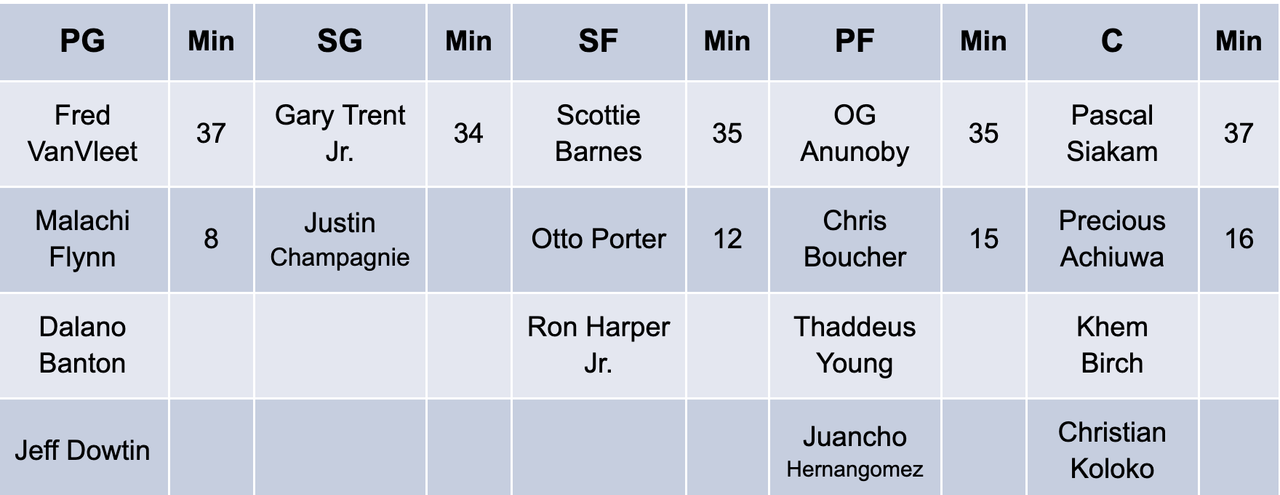
Best Case Scenario:
Fred VanVleet turned in his first All-Star season and Pascal Siakam his second All-NBA season—given that each is still just 28 years of age, they should remain Raptors for a few seasons. Scottie Barnes won Rookie of the Year and he will continue to emerge as the franchise player. OG Anunoby and Gary Trent Jr. are two of the league’s premier fourth and fifth options, and both should continue to improve as neither is older than 25. Toronto’s talent and coaching elevate their competitive floor. With internal improvements, we could be underestimating their ceiling.
Worst Case Scenario:
Nurse burnt his players out hard last season despite the data suggesting long-term consequences of playing extended minutes. Siakam and VanVleet were first and second in the league in minutes per game, respectively. Additionally, Anunoby, Barnes, and Trent Jr. were all top 15 in minutes per game as all five starters averaged 35.0 minutes or more. VanVleet and Trent Jr. broke down as the season wore on as a result, and the Raptors run the risk for worse if this trend continues. The Raptors’ core rotation runs an elevated risk of stress-related and soft tissue injuries with how they’ve been pushed. An inability to recover from nagging issues come playoffs with a significant workload could be a best-case scenario for them as a result. They don’t have the requisite depth to fully overcome injuries, and it feels destined that they will have to face that issue.
How does Scottie Barnes’ offensive role grow in year two?
Even those who were highest on Barnes were surprised by his performance in his rookie season. As a teenager who did not start at Florida State, his versatile defense was supposed to translate with growing pains on offense. While the defense did translate first and heavy minutes made his counting stats pop, Barnes succeeded on the offensive end of the floor at 20 years old. Nearly every aspect of his production surprised, from his 15.3ppg on 49.2% from the floor, his 7.5 boards per night, and even his 3.5 assists. The three-point shooting was not positive at 30.1% on 2.6 attempts per game, but even that was arguably ahead of expectations. Barnes proved himself to be more than a project and was a plus-starter in year one, and he could make a leap this season.
Barnes’ progression suggests he has another gear. Barnes averaged 13.9ppg on 44.7% shooting with an unwillingness to shoot threes when Siakam returned to the lineup in November, but his ability to assert himself for the rest of the season was the reason why he earned Rookie of the Year honors. Over their final 25 games in a larger role, Barnes averaged 17.1-7.7-3.7, and did so on 53.3% shooting as he helped the Raptors go 16-9 despite injuries. Expect Barnes’ greater scoring and distributing stats to translate in year two, with room for more if an injury happens or his three-point shooting improves.
Does Pascal Siakam maintain his All-NBA stats?
Siakam earned All-NBA honors while averaging 22.8-8.5-5.3 on improved shooting splits, the only constant amidst frequent injuries. While he should carry this level of play into this season, his stats could dip. That feels certain if Toronto is healthier, as VanVleet missed 17 games, Trent Jr. sat 12, Anunoby was unavailable for 32, and Barnes missed eight games after Siakam’s debut. The greater volume shooting and facilitating role that he was pressed into as a result of these injuries could decrease, pushing his scoring down closer to 20 per game and his assists to about 4.5 nightly.
Additionally, as Anunoby, Trent and Barnes are 25, 23, and 21 years of age respectively, growth in any of their games could lead to a lesser offensive role for Siakam. His rebounds should remain inflated as he slots into the nominal center position. Siakam can maintain his All-NBA level of play, but if he is not playing hero ball as much then his stats and All-NBA chances should suffer.
Washington Wizards
Added: Will Barton, Monte Morris, Delon Wright, Taj Gibson, Johnny Davis
Lost: Thomas Bryant, Kentavious Caldwell-Pope, Raul Neto, Tomas Satoransky, Ish Smith, Cassius Winston
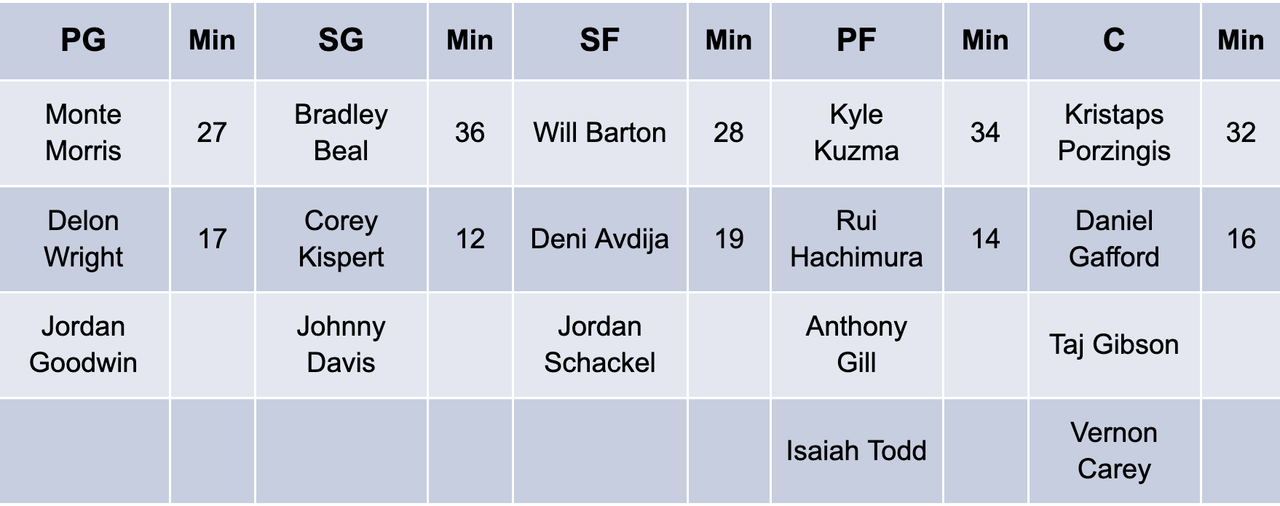
Best Case Scenario:
The Wizards are committed to chasing the playoffs for the duration of Bradley Beal’s five-year extension and have the talent to make a run. Their biggest star bouncing back after a down season is most critical. And with improved health, he can raise his shooting numbers while expending more effort defensively. Kristaps Porzingis has been a wild card for the last few seasons, but his late-season play for the Wizards was fairly inspired. The biggest issues that plagued him prior to arriving in Washington disappeared as he played regularly without public complaint.
Kyle Kuzma was a revelation in Washington after his growth plateaued in Los Angeles, and he appears capable of being the third scorer on this team. Additionally, point guard play went from a joke to competency this offseason with the acquisitions of Monte Morris and Delon Wright. The role players are a mixed bag, but they go 11-deep with viable options. Coach Wes Unseld Jr. needs to make the pieces mesh, but there is enough talent on hand to make the playoffs on paper.
Worst Case Scenario:
Committing $250 million to Beal with a no-trade clause was risky since he has not been able to lead a winning team. If the nearly 30-year-old Beal fails to defend, score, or distribute with efficiency, then this could quickly turn into a frustrating five years. Porzingis was on his best behavior for one month of meaningless Wizards basketball, but it has been years since he has been at his best due to his body and ego. You can envision these two as the cornerstones, but it is difficult to trust them to push the Wizards into the playoffs. Aside from those two, Kuzma faltered off the ball in Los Angeles, and he will be in that role more often. The role players may help, but their defense and shooting are unreliable and none of them really move the needle. This roster impresses on paper, but it’s easy to visualize how they finish sub-.500.
Are we about to see 2020 or 2021 Bradley Beal?
Beal unlocked a level of his game that most did not think he had in 2020. The Wizards gave him Russell Westbrook as a running mate and a roster filled with players who should not have been starting in the NBA. Despite this, they finished eighth in the East and Beal had a heroic season. With averages of 31.3-4.4-4.7 per game, he averaged over 30 points for the second season in a row despite sharing the backcourt with Westbrook. Headed into an extension-eligible season, Beal proved himself as one of the league’s premier bucket-getters, and the Wizards were seen as lucky to have the chance to extend their franchise player.
This past season was the worst of the Beal experience. His assists rose as he handled more of the lead guard role, but his turnovers reached a career-high level. With a bit more surrounding talent, his attempts fell by four shots per game and his free throw attempts dropped by two per. The opportunity to be more selective with his shots should have led to better shooting splits, but instead, he fell off to nearly below 30% from three and 45% from the field. For all the Beal deniers, last season was the textbook case of why he is the ultimate “good stats, bad team” player. There is more talent in Washington again, so his scoring should not rebound to peak 30ppg levels, and in the most likely scenario, he averages around 25-4-6 for this team. He needs to find a way to effectively post those numbers while playing defense to justify his contract.
Does Kristaps Porzingis have his head on straight?
Porzingis missed the entire 2018-2019 season while the Mavs gave him a good-faith extension, and they seemingly never got good faith in return. Following a knee bruise that caused him to eventually miss six weeks last season, Dallas shipped him out for two other bad contracts. Porzingis’ shot selection and commitment to defense and rebounding were problematic, and the Mavericks could not lean into playing their 7’3 big man at center because of these liabilities. Porzingis lacked self-awareness, publicly complaining about how he and Luka Doncic were not treated as equals. The Mavericks did not give up on Porzingis the player, they gave up on the person.
To his credit, Porzingis played 30 minutes with consistency and played back-to-backs for Washington once he arrived, as his soft skills were more present. His shot selection improved, his rebounding numbers increased, and he exhibited more defensive effort and an increased willingness overall. If Porzingis is committed to the Wizards, then he'll get his full stats without restrictions, and he plays more than twice a week. Despite Beal returning, Porzingis could provide 20-9 with assist and block stats reaching career-high levels. If he provides more of the same, then his numbers dip, and he is content to play twice a week without fully being committed. We will see.